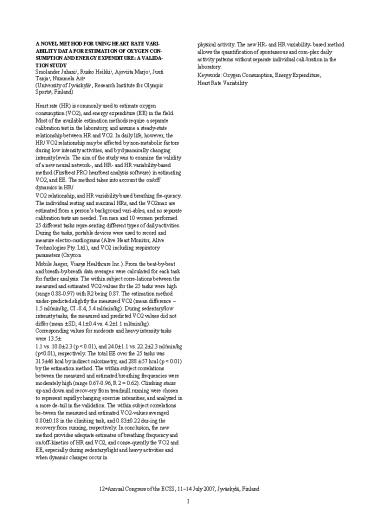A NOVEL METHOD FOR USING HEART RATE VARI - PowerPoint PPT Presentation
1 / 1
Title:
A NOVEL METHOD FOR USING HEART RATE VARI
Description:
A NOVEL METHOD FOR USING HEART RATE VARI- ABILITY DATA FOR ESTIMATION OF OXYGEN CON ... Mobile Jaeger, Viasys Healthcare Inc. ... – PowerPoint PPT presentation
Number of Views:37
Avg rating:3.0/5.0
Title: A NOVEL METHOD FOR USING HEART RATE VARI
1
A NOVEL METHOD FOR USING HEART RATE VARI-
ABILITY DATA FOR ESTIMATION OF OXYGEN CON-
SUMPTION AND ENERGY EXPENDITURE A VALIDA- TION
STUDY Smolander Juhani1, Rusko Heikki1, Ajoviita
Marjo1, Juuti Tanja1, Nummela Ari2 (University
of Jyväskylä1, Research Institute for Olympic
Sports2, Finland) Heart rate (HR) is commonly
used to estimate oxygen consumption (VO2), and
energy expenditure (EE) in the field. Most of the
available estimation methods require a separate
calibration test in the laboratory, and assume a
steady-state relationship between HR and VO2. In
daily life, however, the HR/ VO2 relationship may
be affected by non-metabolic factors during low
intensity activities, and by dynamically changing
intensity levels. The aim of the study was to
examine the validity of a new neural network-,
and HR- and HR variability-based method
(Firstbeat PRO heartbeat analysis software) in
estimating VO2, and EE. The method takes into
account the on/off dynamics in HR/ VO2
relationship, and HR variability based breathing
fre-quency. The individual resting and maximal
HRs, and the VO2max are estimated from a persons
background vari-ables, and no separate
calibration tests are needed. Ten men and 10
women performed 25 different tasks repre-senting
different types of daily activities. During the
tasks, portable devices were used to record and
measure electro-cardiograms (Alive Heart Monitor,
Alive Technologies Pty. Ltd.), and VO2 including
respiratory parameters (Oxycon Mobile Jaeger,
Viasys Healthcare Inc.). From the beat-by-beat
and breath-by-breath data averages were
calculated for each task for further analysis.
The within subject corre-lations between the
measured and estimated VO2-values for the 25
tasks were high (range 0.88-0.97) with R2 being
0.87. The estimation method under-predicted
slightly the measured VO2 (mean difference 1.5
ml/min/kg, CI -8.4, 5.4 ml/min/kg). During
sedentary/low intensity tasks, the measured and
predicted VO2 values did not differ (mean SD,
4.10.4 vs. 4.21.1 ml/min/kg). Corresponding
values for moderate and heavy intensity tasks
were 13.5 1.1 vs. 10.02.3 (p lt 0.01), and
24.01.1 vs. 22.22.3 ml/min/kg (plt0.01),
respectively. The total EE over the 25 tasks was
31546 kcal by indirect calorimetry, and 288 57
kcal (p lt 0.01) by the estimation method. The
within subject correlations between the measured
and estimated breathing frequencies were
moderately high (range 0.67-0.96, R 2 0.62).
Climbing stairs up and down and recov-ery from
treadmill running were chosen to represent
rapidly changing exercise intensities, and
analyzed in a more de-tail in the validation. The
within subject correlations be-tween the measured
and estimated VO2-values averaged 0.800.18 in
the climbing task, and 0.830.22 dur-ing the
recovery from running, respectively. In
conclusion, the new method provides adequate
estimates of breathing frequency and
on/off-kinetics of HR and VO2, and conse-quently
the VO2 and EE, especially during sedentary/light
and heavy activities and when dynamic changes
occur in
physical activity. The new HR- and HR
variability- based method allows the
quantification of spontaneous and com-plex daily
activity patterns without separate individual
cali-bration in the laboratory. Keywords Oxygen
Consumption, Energy Expenditure, Heart Rate
Variability
12thAnnual Congress of the ECSS, 1114 July 2007,
Jyväskylä, Finland I































